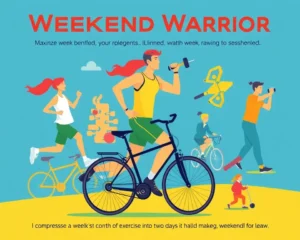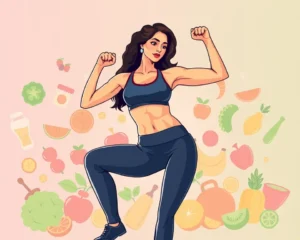Maintaining physical fitness is a lifelong journey, and the best exercises for your body evolve as you age. A fitness expert has curated a guide to the most effective exercises for each decade of life, ensuring you stay strong, healthy, and energized no matter your age. Tailoring your workout routine to your specific needs and abilities at each stage can optimize your results and minimize the risk of injury, making fitness a sustainable and enjoyable part of your life.
Fitness in Your 20s: Building a Strong Foundation
The 20s are often a period of peak physical capability, making it an ideal time to establish a solid fitness foundation. High-intensity workouts and strength training are particularly beneficial during this decade.
High-Intensity Interval Training (HIIT)
HIIT workouts involve short bursts of intense exercise followed by brief recovery periods.
- Benefits: HIIT is excellent for burning calories, improving cardiovascular fitness, and boosting metabolism.
- Examples: Sprinting, burpees, jumping jacks, and cycling.
- Why it’s ideal: This decade offers the energy and resilience to push through challenging workouts, maximizing the benefits of HIIT for long-term health.
Strength Training
Focus on compound exercises that work multiple muscle groups simultaneously.
- Benefits: Builds muscle mass, increases bone density, and improves overall strength.
- Examples: Squats, deadlifts, bench presses, and overhead presses.
- Why it’s ideal: Building a strong muscular foundation in your 20s sets the stage for maintaining strength and mobility in later years.
Fitness in Your 30s: Balancing Act and Injury Prevention
The 30s often bring increased responsibilities, making time management crucial for maintaining a fitness routine. Focusing on functional fitness and injury prevention becomes increasingly important.
Functional Fitness
Exercises that mimic everyday movements.
- Benefits: Improves balance, coordination, and overall functional strength, making daily tasks easier and reducing the risk of injury.
- Examples: Lunges, push-ups, rows, and planks.
- Why it’s ideal: Functional fitness prepares the body for the demands of daily life, enhancing overall quality of life.
Yoga and Pilates
These practices improve flexibility, core strength, and body awareness.
- Benefits: Reduces stress, enhances posture, and prevents injuries.
- Why it’s ideal: Yoga and Pilates provide a balanced approach to fitness, addressing both physical and mental well-being, which is particularly important during the demanding 30s.
Fitness in Your 40s: Maintaining Muscle Mass and Joint Health
As you enter your 40s, maintaining muscle mass and protecting joint health become priorities. Incorporating low-impact exercises and strength training is essential.
Low-Impact Cardio
Activities that are gentle on the joints.
- Benefits: Improves cardiovascular health without putting excessive stress on the joints.
- Examples: Swimming, cycling, walking, and elliptical training.
- Why it’s ideal: Low-impact cardio provides a sustainable way to stay active and maintain cardiovascular fitness as you age.
Strength Training (with modifications)
Continue strength training, but with adjustments to accommodate any joint pain or limitations.
- Benefits: Preserves muscle mass, boosts metabolism, and strengthens bones.
- Examples: Modified squats (using a chair for support), dumbbell rows, and resistance band exercises.
- Why it’s ideal: Maintaining muscle mass is crucial for overall health and vitality in the 40s, and modified strength training makes it accessible and safe.
Fitness in Your 50s: Bone Density and Balance
In the 50s, focusing on exercises that improve bone density and balance becomes increasingly important to prevent falls and maintain overall mobility.
Weight-Bearing Exercises
Activities that put stress on the bones, promoting bone density.
- Benefits: Strengthens bones, reduces the risk of osteoporosis, and improves balance.
- Examples: Walking, jogging, dancing, and stair climbing.
- Why it’s ideal: Weight-bearing exercises are essential for maintaining bone health and preventing age-related bone loss.
Balance Exercises
Exercises that challenge your stability.
- Benefits: Improves balance, coordination, and reduces the risk of falls.
- Examples: Tai chi, yoga, and single-leg stands.
- Why it’s ideal: Improving balance can significantly enhance overall mobility and independence in the 50s.
Fitness in Your 60s and Beyond: Mobility and Independence
For those in their 60s and beyond, the focus shifts to maintaining mobility, independence, and overall quality of life. Gentle exercises and regular physical activity are key.
Chair Exercises
Exercises that can be performed while seated.
- Benefits: Improves strength, flexibility, and circulation without putting stress on the joints.
- Examples: Seated arm raises, leg extensions, and torso twists.
- Why it’s ideal: Chair exercises provide a safe and accessible way to stay active for individuals with limited mobility.
Walking
A simple yet effective exercise for overall health.
- Benefits: Improves cardiovascular health, strengthens bones, and enhances mood.
- Why it’s ideal: Walking is a low-impact activity that can be easily incorporated into daily life, promoting overall well-being.
Additional Tips for Lifelong Fitness
Stay Consistent
Consistency is key to achieving and maintaining fitness at any age.
- How: Establish a regular workout schedule and stick to it as much as possible.
Listen to Your Body
Pay attention to any pain or discomfort and adjust your workouts accordingly.
- How: Don’t push yourself too hard, especially when starting a new exercise program.
Stay Hydrated
Drink plenty of water throughout the day to support your body’s functions.
- How: Carry a water bottle with you and sip on it regularly.
Consult with a Professional
Consider working with a personal trainer or physical therapist to develop a customized fitness plan.
- How: A professional can provide guidance on proper form, exercise selection, and injury prevention.
Make It Enjoyable
Choose activities that you enjoy to make exercise a sustainable part of your life.
- How: Experiment with different types of exercise until you find something that you look forward to doing.







